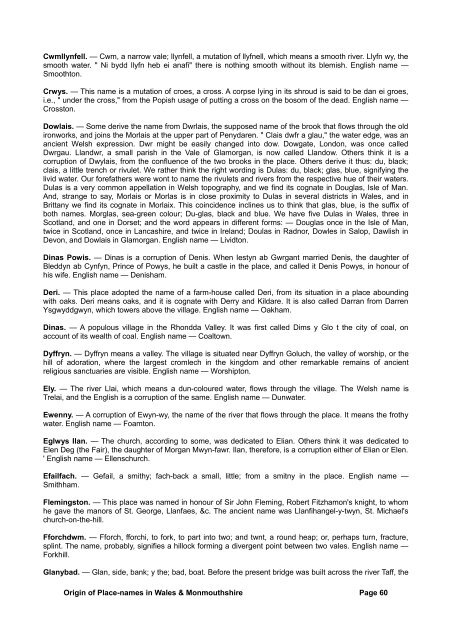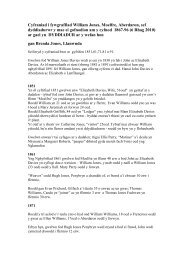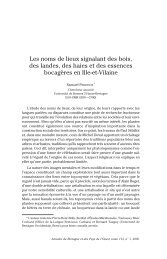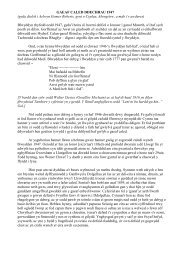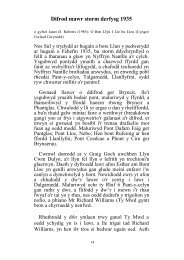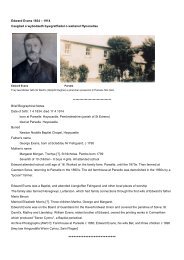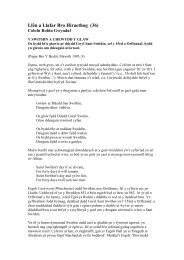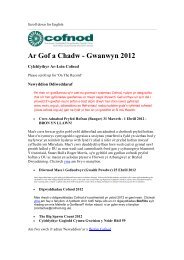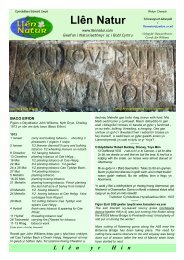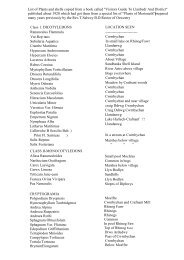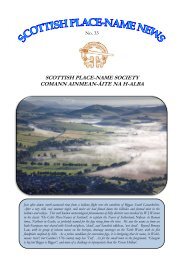<strong>and</strong> her horns stuck <strong>in</strong> <strong>the</strong> arch; <strong>the</strong> <strong>place</strong> be<strong>in</strong>g so narrow, she could nei<strong>the</strong>r move onwards or backwards,<strong>and</strong> ultimately <strong>the</strong> owner had no alternative but to kill her on <strong>the</strong> spot. The town's coat <strong>of</strong> arms ever s<strong>in</strong>ce is<strong>the</strong> figure <strong>of</strong> a cow st<strong>and</strong><strong>in</strong>g on a bridge.Cheriton. — Probably a corruption <strong>of</strong> Cherry-town, so called from its abundance <strong>of</strong> cherries <strong>in</strong> olden times.Cilbebyll. — Cil, a hidden <strong>place</strong> ; pebyll, tents ; signify<strong>in</strong>g <strong>the</strong> retreat <strong>of</strong> <strong>the</strong> tents. It was customary <strong>in</strong> oldentimes to repair to temporary tents <strong>in</strong> sequestered <strong>place</strong>s <strong>in</strong> <strong>the</strong> summer. This sequestered <strong>place</strong> comm<strong>and</strong>s abeautiful view <strong>of</strong> <strong>the</strong> sea, <strong>and</strong> <strong>the</strong> surround<strong>in</strong>g district. English name — Nookham.Cymer. — From cym-mer, which literally means a confluence or junction. Several <strong>place</strong>s <strong>in</strong> Wales are calledCymer, from <strong>the</strong>ir situation on <strong>the</strong> junction <strong>of</strong> rivers, as Pontycymer, Cymer Glyn Corwg, &c. English name —Biwater.Cyfarthfa. — Cyfarthfa is <strong>the</strong> right name accord<strong>in</strong>g to some, signify<strong>in</strong>g <strong>the</strong> <strong>place</strong> <strong>of</strong> bark<strong>in</strong>g. It is said that itwas a general rendezvous for hunters. One writer th<strong>in</strong>ks it is a corruption <strong>of</strong> Cyfarwydd-fa, <strong>the</strong> <strong>place</strong> <strong>of</strong> CwtaCyfarwydd, one <strong>of</strong> <strong>the</strong> heroes <strong>of</strong> Welsh legend. English name — Barkham.Colw<strong>in</strong>stone. — A translation <strong>of</strong> <strong>the</strong> Welsh name, Tregolwyn, Colw<strong>in</strong>'s town.Cadle. — Cad, battle; lie, <strong>place</strong>; signify<strong>in</strong>g a battlefield. Cad is derived from <strong>the</strong> Sanskrit had, to hurt or kill. Itis supposed that a terrible battle was fought here at some remote period. English name — Battleton.Clydach. — The village takes its name from <strong>the</strong> rivulet Clydach, which discharges itself <strong>in</strong>to <strong>the</strong> river Tawy.Some trace <strong>the</strong> name to <strong>the</strong> Gaelic clith, strong. We have <strong>the</strong> Clyde <strong>in</strong> Scotl<strong>and</strong>, <strong>the</strong> Clwyd <strong>in</strong> Wales, <strong>and</strong> <strong>the</strong>Glyde <strong>in</strong> Irel<strong>and</strong>. O<strong>the</strong>rs refer it to cludo, to carry. We have <strong>the</strong> Cludan <strong>in</strong> Scotl<strong>and</strong>, <strong>and</strong> Strathclud, or <strong>the</strong>k<strong>in</strong>gdom <strong>of</strong> <strong>the</strong> Clyde. We <strong>of</strong>fer <strong>the</strong> follow<strong>in</strong>g: Clyd, shelter<strong>in</strong>g, warm; ach, a river; signify<strong>in</strong>g a river flow<strong>in</strong>gthrough a shelter<strong>in</strong>g <strong>place</strong>. English name — Shelterham.Cabalfa. — A corruption probably <strong>of</strong> ceubalfa, which signifies a ferry<strong>in</strong>g-<strong>place</strong>. English name — Ferryham.Crossvane. — An Anglicized form <strong>of</strong> Croesfaen, which signifies <strong>the</strong> cross stone. English name — Crossstone.Coyty. — A corruption <strong>of</strong> coed, wood, <strong>and</strong> ty, a house, signify<strong>in</strong>g a wood-house. English name — Woodby.Cors E<strong>in</strong>ion. — Cors, a bog; E<strong>in</strong>ion, <strong>the</strong> name <strong>of</strong> a descendant <strong>of</strong> Howell <strong>the</strong> Good. History tells us that heled an army twice to Gower, <strong>and</strong> on his way thi<strong>the</strong>r he probably encamped here. The name <strong>of</strong> E<strong>in</strong>ion is bornedown to us also <strong>in</strong> Port Eynion Bay. It is a strange co<strong>in</strong>cidence that <strong>the</strong> name E<strong>in</strong>ion signifies "our leader."English name — Leaderham.Caerau. — The church was built on <strong>the</strong> ru<strong>in</strong>s <strong>of</strong> an old Roman fortress; hence <strong>the</strong> name. English name —Fortham.Cwmgiedd. — Cwm, a narrow vale; Giedd, <strong>the</strong> name <strong>of</strong> <strong>the</strong> rivulet that runs through it to <strong>the</strong> Tawy; hence<strong>the</strong> name. We are <strong>in</strong>cl<strong>in</strong>ed to th<strong>in</strong>k Giedd is a contraction <strong>of</strong> gwy eidden, which signifies noisy water, <strong>in</strong>contradist<strong>in</strong>ction from taw-wy, <strong>the</strong> smooth or silent water, <strong>and</strong> llyfnell, <strong>the</strong> smooth water. English name —D<strong>in</strong>vale.Cwmtwrch. — The river Twrch rushes through <strong>the</strong> combe <strong>and</strong> empties <strong>in</strong>to <strong>the</strong> Tawy near Ystalyfera. Twrch,probably, is a derivation <strong>of</strong> tyrchu, to turn up, to burrow. The Welsh for a mole is twrch daear, from itsburrow<strong>in</strong>g nature. English name — Boarcombe.Coychurch. — Coy, is, probably, a corruption <strong>of</strong> coed, wood; <strong>the</strong> name signify<strong>in</strong>g <strong>the</strong> church <strong>in</strong> <strong>the</strong> wood.Pencoed is <strong>in</strong> <strong>the</strong> same parish. The Welsh name is Llangrallo, from Crallo, <strong>the</strong> founder <strong>and</strong> patron sa<strong>in</strong>t <strong>of</strong><strong>the</strong> church, <strong>and</strong> a nephew to Illtyd. English name — Woodchurch.Cenffig. — Probably a compound <strong>of</strong> cefn, a ridge, <strong>and</strong> tnignen, a bog, signify<strong>in</strong>g a ridge above a bog, whichanswers to <strong>the</strong> position <strong>of</strong> <strong>the</strong> <strong>place</strong>. English name — Bogridge.Cogan. — A corruption, perhaps, <strong>of</strong> Gwgan, <strong>the</strong> name <strong>of</strong> a celebrated Welsh personage.Orig<strong>in</strong> <strong>of</strong> Place-<strong>names</strong> <strong>in</strong> Wales & Monmouthshire Page 59
Cwmllynfell. — Cwm, a narrow vale; llynfell, a mutation <strong>of</strong> llyfnell, which means a smooth river. Llyfn wy, <strong>the</strong>smooth water. " Ni bydd llyfn heb ei anafi" <strong>the</strong>re is noth<strong>in</strong>g smooth without its blemish. English name —Smoothton.Crwys. — This name is a mutation <strong>of</strong> croes, a cross. A corpse ly<strong>in</strong>g <strong>in</strong> its shroud is said to be dan ei groes,i.e., " under <strong>the</strong> cross," from <strong>the</strong> Popish usage <strong>of</strong> putt<strong>in</strong>g a cross on <strong>the</strong> bosom <strong>of</strong> <strong>the</strong> dead. English name —Crosston.Dowlais. — Some derive <strong>the</strong> name from Dwrlais, <strong>the</strong> supposed name <strong>of</strong> <strong>the</strong> brook that flows through <strong>the</strong> oldironworks, <strong>and</strong> jo<strong>in</strong>s <strong>the</strong> Morlais at <strong>the</strong> upper part <strong>of</strong> Penydaren. " Clais dwfr a glau," <strong>the</strong> water edge, was anancient Welsh expression. Dwr might be easily changed <strong>in</strong>to dow. Dowgate, London, was once calledDwrgau. Ll<strong>and</strong>wr, a small parish <strong>in</strong> <strong>the</strong> Vale <strong>of</strong> Glamorgan, is now called Ll<strong>and</strong>ow. O<strong>the</strong>rs th<strong>in</strong>k it is acorruption <strong>of</strong> Dwylais, from <strong>the</strong> confluence <strong>of</strong> <strong>the</strong> two brooks <strong>in</strong> <strong>the</strong> <strong>place</strong>. O<strong>the</strong>rs derive it thus: du, black;clais, a little trench or rivulet. We ra<strong>the</strong>r th<strong>in</strong>k <strong>the</strong> right word<strong>in</strong>g is Dulas: du, black; glas, blue, signify<strong>in</strong>g <strong>the</strong>livid water. Our forefa<strong>the</strong>rs were wont to name <strong>the</strong> rivulets <strong>and</strong> rivers from <strong>the</strong> respective hue <strong>of</strong> <strong>the</strong>ir waters.Dulas is a very common appellation <strong>in</strong> Welsh topography, <strong>and</strong> we f<strong>in</strong>d its cognate <strong>in</strong> Douglas, Isle <strong>of</strong> Man.And, strange to say, Morlais or Morlas is <strong>in</strong> close proximity to Dulas <strong>in</strong> several districts <strong>in</strong> Wales, <strong>and</strong> <strong>in</strong>Brittany we f<strong>in</strong>d its cognate <strong>in</strong> Morlaix. This co<strong>in</strong>cidence <strong>in</strong>cl<strong>in</strong>es us to th<strong>in</strong>k that glas, blue, is <strong>the</strong> suffix <strong>of</strong>both <strong>names</strong>. Morglas, sea-green colour; Du-glas, black <strong>and</strong> blue. We have five Dulas <strong>in</strong> Wales, three <strong>in</strong>Scotl<strong>and</strong>, <strong>and</strong> one <strong>in</strong> Dorset; <strong>and</strong> <strong>the</strong> word appears <strong>in</strong> different forms: — Douglas once <strong>in</strong> <strong>the</strong> Isle <strong>of</strong> Man,twice <strong>in</strong> Scotl<strong>and</strong>, once <strong>in</strong> Lancashire, <strong>and</strong> twice <strong>in</strong> Irel<strong>and</strong>; Doulas <strong>in</strong> Radnor, Dowles <strong>in</strong> Salop, Dawlish <strong>in</strong>Devon, <strong>and</strong> Dowlais <strong>in</strong> Glamorgan. English name — Lividton.D<strong>in</strong>as Powis. — D<strong>in</strong>as is a corruption <strong>of</strong> Denis. When Iestyn ab Gwrgant married Denis, <strong>the</strong> daughter <strong>of</strong>Bleddyn ab Cynfyn, Pr<strong>in</strong>ce <strong>of</strong> Powys, he built a castle <strong>in</strong> <strong>the</strong> <strong>place</strong>, <strong>and</strong> called it Denis Powys, <strong>in</strong> honour <strong>of</strong>his wife. English name — Denisham.Deri. — This <strong>place</strong> adopted <strong>the</strong> name <strong>of</strong> a farm-house called Deri, from its situation <strong>in</strong> a <strong>place</strong> abound<strong>in</strong>gwith oaks. Deri means oaks, <strong>and</strong> it is cognate with Derry <strong>and</strong> Kildare. It is also called Darran from DarrenYsgwyddgwyn, which towers above <strong>the</strong> village. English name — Oakham.D<strong>in</strong>as. — A populous village <strong>in</strong> <strong>the</strong> Rhondda Valley. It was first called Dims y Glo t <strong>the</strong> city <strong>of</strong> coal, onaccount <strong>of</strong> its wealth <strong>of</strong> coal. English name — Coaltown.Dyffryn. — Dyffryn means a valley. The village is situated near Dyffryn Goluch, <strong>the</strong> valley <strong>of</strong> worship, or <strong>the</strong>hill <strong>of</strong> adoration, where <strong>the</strong> largest cromlech <strong>in</strong> <strong>the</strong> k<strong>in</strong>gdom <strong>and</strong> o<strong>the</strong>r remarkable rema<strong>in</strong>s <strong>of</strong> ancientreligious sanctuaries are visible. English name — Worshipton.Ely. — The river Llai, which means a dun-coloured water, flows through <strong>the</strong> village. The Welsh name isTrelai, <strong>and</strong> <strong>the</strong> English is a corruption <strong>of</strong> <strong>the</strong> same. English name — Dunwater.Ewenny. — A corruption <strong>of</strong> Ewyn-wy, <strong>the</strong> name <strong>of</strong> <strong>the</strong> river that flows through <strong>the</strong> <strong>place</strong>. It means <strong>the</strong> frothywater. English name — Foamton.Eglwys Ilan. — The church, accord<strong>in</strong>g to some, was dedicated to Elian. O<strong>the</strong>rs th<strong>in</strong>k it was dedicated toElen Deg (<strong>the</strong> Fair), <strong>the</strong> daughter <strong>of</strong> Morgan Mwyn-fawr. Ilan, <strong>the</strong>refore, is a corruption ei<strong>the</strong>r <strong>of</strong> Elian or Elen.' English name — Ellenschurch.Efailfach. — Gefail, a smithy; fach-back a small, little; from a smitny <strong>in</strong> <strong>the</strong> <strong>place</strong>. English name —Smithham.Flem<strong>in</strong>gston. — This <strong>place</strong> was named <strong>in</strong> honour <strong>of</strong> Sir John Flem<strong>in</strong>g, Robert Fitzhamon's knight, to whomhe gave <strong>the</strong> manors <strong>of</strong> St. George, Llanfaes, &c. The ancient name was Llanfihangel-y-twyn, St. Michael'schurch-on-<strong>the</strong>-hill.Fforchdwm. — Fforch, fforchi, to fork, to part <strong>in</strong>to two; <strong>and</strong> twnt, a round heap; or, perhaps turn, fracture,spl<strong>in</strong>t. The name, probably, signifies a hillock form<strong>in</strong>g a divergent po<strong>in</strong>t between two vales. English name —Forkhill.Glanybad. — Glan, side, bank; y <strong>the</strong>; bad, boat. Before <strong>the</strong> present bridge was built across <strong>the</strong> river Taff, <strong>the</strong>Orig<strong>in</strong> <strong>of</strong> Place-<strong>names</strong> <strong>in</strong> Wales & Monmouthshire Page 60
- Page 1 and 2:
HANDBOOK OF THE ORIGIN OF PLACE-NAM
- Page 3 and 4:
§ § § § §The Author begs to st
- Page 5 and 6:
pitiful cries of the railway offici
- Page 7 and 8:
Bishop Percy says that "in England,
- Page 9 and 10:
The city of Chester is still popula
- Page 11 and 12: There's Cumwhitton, Cumwhinton, Cum
- Page 13 and 14: Llwyn in its primary' sense means a
- Page 15 and 16: PLACE-NAMES IN WALES.Wales. — The
- Page 17 and 18: Church are generally dedicated to e
- Page 19 and 20: think he was a contemporary of St.
- Page 21 and 22: Rhosbeirio. — Rhos, a moor, a dry
- Page 23 and 24: of Brecknock," states that this vic
- Page 25 and 26: Cam cnwir ef Cwmdu,Cwm gwyn yw & n
- Page 27 and 28: Penderyn. — A corruption probably
- Page 29 and 30: Ardudwy. — Ar, upon or above; tud
- Page 31 and 32: to mark its pre-eminence over the o
- Page 33 and 34: Some think that eirw is a corruptio
- Page 35 and 36: present form — Caerfyrddin.Abergw
- Page 37 and 38: place of refuge; hence the name. En
- Page 39 and 40: Llansawyl. — The church was dedic
- Page 41 and 42: eject. The village took its name fr
- Page 43 and 44: house, and attempted to kill an inf
- Page 45 and 46: Gwydir. — Prima facie one may tak
- Page 47 and 48: Nefyn. — The church was probably
- Page 49 and 50: DENBIGHSHIRE.Anglicized form of Din
- Page 51 and 52: Llangollen. — From Collen, a sain
- Page 53 and 54: hands into their pockets to pay a c
- Page 55 and 56: Cefn. — The name signifies a ridg
- Page 57 and 58: Maesgarmon. — Named in honour of
- Page 59 and 60: Abertridwr. — Tridwr, three water
- Page 61: it is said, was originally built by
- Page 65 and 66: Gwarycaeau. — Gwdr, the nape of t
- Page 67 and 68: means a cultivated region, a vale,
- Page 69 and 70: Penrhiwfer.- Pen, head, top; rhiw,
- Page 71 and 72: Port Talbot. — So called in 1835
- Page 73 and 74: Trealaw. — This appellation was g
- Page 75 and 76: Aberdyfi. — So called from its si
- Page 77 and 78: Llanddwywe. — From Dwywau, a desc
- Page 79 and 80: Crickhowell and some in the directi
- Page 81 and 82: Griffithstown. — This village was
- Page 83 and 84: and gwy, water. Treiddiod troth tna
- Page 85 and 86: derive Tintern from din, fortified
- Page 87 and 88: Caersws. — It appears that the Ro
- Page 89 and 90: English name — Ervylton.Llanymech
- Page 91 and 92: Angle. — Probably from the angle-
- Page 93 and 94: Gellyswick. — Another hybrid. Gel
- Page 95 and 96: that the two rivers in their flowin
- Page 97 and 98: ecame the bishop of the see, and wa
- Page 99 and 100: earth formerly stood on a summit on
- Page 101 and 102: Pilleth. — A corruption of pwll,
- Page 103 and 104: Howells, Rev. J., Mountain AshHowel
- Page 105 and 106: Williams, D., PenywernWilliams, Rev


